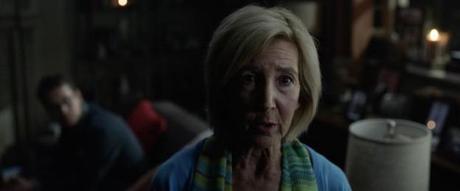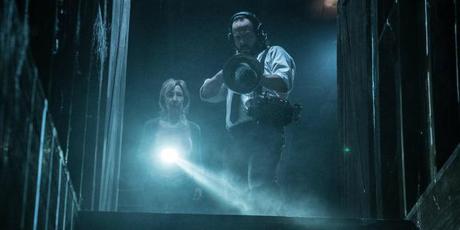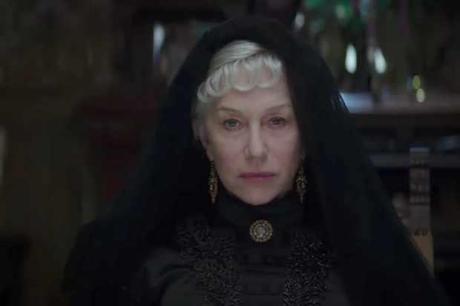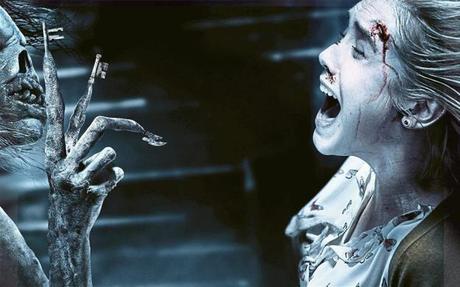Helen Mirren. Dressed all in black. Starring in a horror movie.
Well, I'm sold. You've got my money, Winchester: The House That Ghosts Built (or, more accurately, MoviePass has my money).
That's just about the only thought I put into my ticket-buying decision earlier tonight. It also helped that I'd read a little bit about the real Winchester house the movie is based on, but mostly I was there for Dame Mirren. However, I left oddly realizing just how comparatively better Lin Shaye's horror movies are. It took seeing Winchester for me to fully appreciate Insidious: The Last Key.
Allow me to explain.

Lin Shaye, the sister to famous New Line founder Bob Shaye, has been a recognizable character actress for years, popping up in lots of horror movies and enjoying a good run there for a while with the Farrelly Brothers thanks to supporting parts in Dumb and Dumber, Kingpin, and There's Something About Mary. However, it wasn't until she was in her seventies that she finally headlined her own franchise: Insidious. It was an entirely improbable turn of events, and not just because of her age.
Insidious, everyone's favorite Poltergeist rip-off movie, morphed into something more explicitly about astral-projection than hauntings in its first sequel, but by the third film original franchise stars Patrick Wilson and Rose Byrne bowed out. The keys were handed over to Shaye, whose psychic/medium character Elise initially served as the Zelda Rubinstein to their Wilson's Craig T. Nelson and Byrne's JoBeth Williams.
Here's where it gets tricky: [spoiler from 8 years ago] Elise dies at the end of the first Insidious, yet everyone loved her and her comic relief sidekicks, the ghost hunters. So, the producers decided to make Insidious: Chapter 3 (2015) and Insidious: The Last Key (which came out last month)prequels focused on Elise's earlier life and career, with The Last Key taking her right up to the moment she first receives the call to help the family depicted in the first film.

Perhaps as a reflection of the change in lead character or perhaps owing to writers and directors simply wanting to do something different, these Lin Shaye-led Insidious movies are surprisingly emotional and character-based.
The Last Key, for example, depicts Elise taking a case investigating a haunting at the house she grew up in, which triggers multiple flashbacks to her troubled childhood. We learn that since she was gifted with her medium abilities at a young age she was routinely beaten by her small-minded father who wanted her to deny/suppress who she really was and what she could do. Beyond the abuse at the hands of her father, the younger Elise was also a target for predatory ghosts and demons aiming to use her ability as a springboard into the world. Thus, Last Key elevates poor Elise to a horror film hero for the abused and ostracised.
The little matter of actually scaring the audience, though, is more of a secondary concern to the larger narrative about a woman finally confronting her ghosts, both literal and figurative. As a result, The Last Key is a horror movie that is overall not especially scary.

The same, sadly, is true of Winchester, a rather quaint ghost story that likely works best as a gateway horror film (it's a rather tame, gore-free, tension-lite PG-13) but still largely wastes the dramatic potential of its premise.
It's 1906. A laudanum-addicted, permanently vacationing psychiatrist (Jason Clarke) is commissioned by the Winchester Repeating Rifle Company board to visit Sarah Winchester, who owns half of the company, and declare her mentally unfit. Oh, technically, he's just supposed to evaluate and offer his honest opinion, but the 1906 Gentleman's Code language they adopt is easy to translate: Say the woman's crazy and we'll pay off your debts and even leave you with plenty of money to keep buying drugs to get high.
Those bastards! How dare they do that to Helen Mirren! Er, I mean Sarah Winchester.Yeah, funny thing about that. This isn't just some sexist powerplay engineered by early 20th century men looking to edge a woman out of a position of power. Their concerns about her are entirely reasonable. Because what, really, are they to make of a woman who purchased an eight-room, two-story farmhouse in San Jose, California in 1886, and almost immediately began adding new rooms, some of which she'd mysteriously tear down just as quickly as it had been built?
Well, that just makes her eccentri...And she enlisted contractors to work 24-hours a day, 365 days each year.
Correction. A clearly committed eccentric.Ghosts! She was doing it all to trap ghosts.
Wait. What?Shortly after her husband's death, Sarah visited a medium who filled her head with talk of a Winchester family curse. The universe couldn't allow her family to go unpunished, not after the way they'd profited off of so much pain, indiscriminately peddling glorified death sticks to everyone and anyone. So, her husband died of tuberculosis, and her daughter died two weeks after birth. The curse would claim her and her niece (played by Sarah Snook) and nephew as well if she didn't provide refuge to all the angry souls who'd lost their life due to a Winchester rifle.

The house was her way of doing that. Every night at midnight, she'd conduct a seance, claim to be possessed by one of the ghosts, madly sketch plans for a new room in the house according to their wishes, and then hand the sketch to her on-site foreman. Once completed, the room would either serve as the gateway for the ghost to finally achieve peace and pass on or an impromptu trap, the door nailed shut down with 13 nails, a holy number in Winchester's estimation.
Okay. I can see where that might concern people.All of that is entirely accurate to what the real Sarah Winchester believed and did. At its height, her Winchester home grew to 24,000 square feet, 500 rooms, 40 bedrooms, six kitchens, 2,000 doors, 10,000 windowpanes, and 47 fireplaces with only 17 chimneys.
The film uses Clarke's investigation to first explain all of that to us and then to prove that she was right. Almost immediately after his arrival, he starts seeing ghosts, yet he spends most of his time as the skeptic seeking rational explanations when the answer is right in front of him the whole time. Mirren's Winchester is the Elise of the story, communicating with unseen ghosts in both friendly and unfriendly terms depending on the psychic feeling she gets off of them. By the end, Clarke's tortured backstory comes into play quite significantly, and he partners with Sarah to duke it out with an especially vengeful spirit.
Yet even with that fantastic premise and two capable leads Winchester somehow manages to be little more than a colossal bore, with its notion of horror coming down to a simple collection of uninspired jump cuts and possessed-little-kid-in-peril cliches (in this case, Sarah's ginger-haired nephew). The Last Key, to be fair, is also a bit of a dud, at least by Insidious franchise standards. However, there are moments of genuine terror in that film which speak to the immense talents of all involved. Elise quarrels with a malformed monster which can use its key-shaped finger to reach into a person's throat and turn off their vocal chords, thus robbing them of their scream as they look into his terrifying face. Winchester, um, doesn't have anything like that.

Perhaps that's an unfair comparison since Winchester deals explicitly with ghosts whereas Last Key is free to incorporate demons. So, instead, take the example of the jump cuts. Last Key uses them quite judiciously, dropping several in quick succession in the opening scene and then pulling back until much later in the story. Winchester, on the other hand, has one creeping around every corner at every minute of the movie.
Most notably, both films feature the now-familiar prolonged scene where the director endlessly tease our expectation of a jump scare. In Last Key' s case, it comes while Elise is in a confined space with limited lighting and routinely directing her flashlight into the darkness to see if there's anything there. She's newly discovered old stacks of luggage, and every time she opens one of the suitcases to inspects its contents the lid occupies the majority of the frame, creating the expectation that once she closes the lid there will be a ghost there to scare us. Director Adam Robitel plays this little game of "When's the scare gonna come?" beautifully, stretching it far beyond expectations so that the exact moment we let our guard down, thinking "I guess nothing's gonna happen" is exactly when the scare pops up, emanating not all from the space in the frame we were expecting it to either. There's an artistry to this glorified yelling of "Boo!" which Robitel clearly knows his way around.
Winchester's directors The Spierig Brothers ( Jigsaw, Daybreakers, Predestination) seem comparatively less certain of what they're doing. In their similar scene, Clarke's character talks to himself while the mirror in front of him consistently pivots from one side of the room to another, reflecting his face one second, the chair behind him the next. We've yet to see a ghost to this point, but with this particular setup we know to expect something scary to show up either in the reflection of the chair, a reflection of Clarke himself, or even behind the mirror. The Spierig neither stretch this out for maximum tension nor do they see fit to even settle on one jump scare, showing us a ghost in one area of the room one second, then another ghost in another area immediately after that, doubling up on the same technique and somewhat unintentionally immunizing us to its effect.
Neither film is perfect. The Last Key features some bizarre dramatic transitions and broad comedy scenes which run counter to the tone of the movie. Winchester doesn't even have a proper establishing shot of its titular home, instead offering a sweeping, aerial movement above the house long after we've already been in it. Even then, we still leave the film without a full sense of just how massive the house is. But in the limited pantheon of horror movies led by septuagenarians, The Last Key is at least more competently put together.
The upside, of course, is that there are now several horror movies led by women in their seventies. Score one for roles for older women. Winchester even ends with the clear hint that they'd like to make another one. But, and it's rare to get to say this, sorry Helen Mirren - Lin Shaye did it better.
RANDOM PARTING THOUGHTS- For a movie with a 13 Ghosts-like premise, there aren't actually a lot of ghosts in Winchester. Owing most likely to budgetary concerns, there are more close-ups of nails (as in the nails used to boardrooms shut and trap ghosts) than there are shots of individual ghosts scaring people.
- Winchester really expects audiences to recognize the significance of the year 1906 in California history.
- There were, surprisingly, a lot of little kids with their parents at my screening of Winchester, and the ones I could hear seemed particularly into it while by the end the adults were snickering. That's partially why this strikes me as more of a gateway horror movie.
- Winchester and Last Key share a cast member: Angus Sampson, who plays one of Lin Shaye's ghost hunters and one of Helen Mirren's enforcers.

